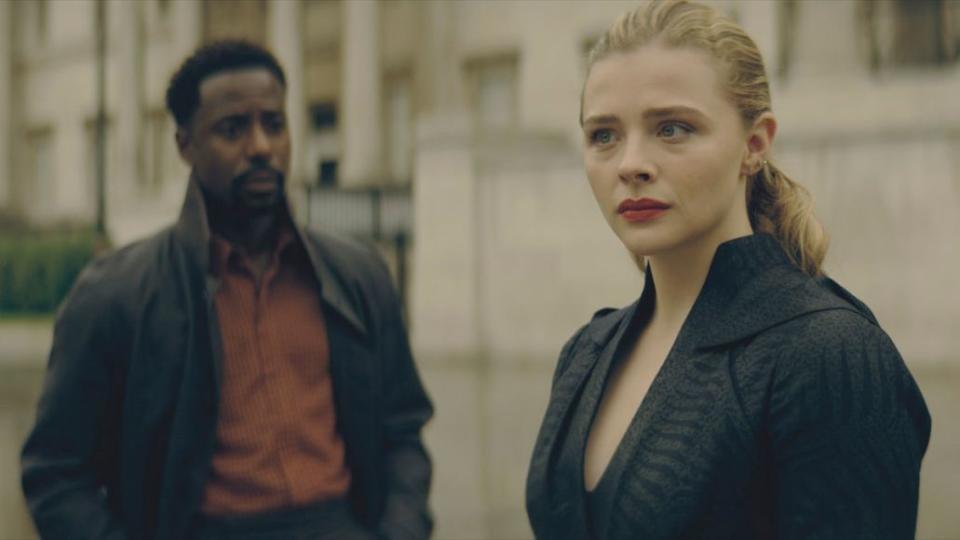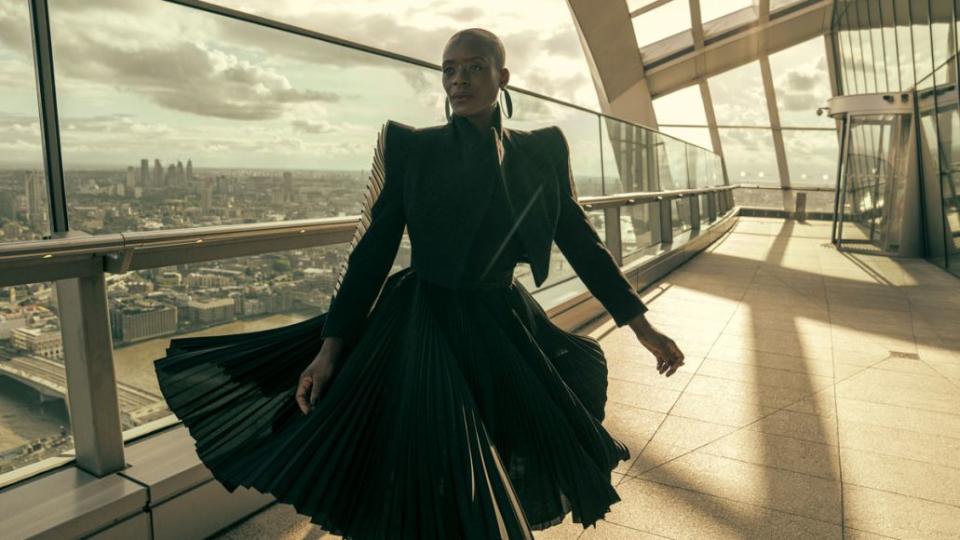Chloe Grace Moretz on Finding Hope in The Peripheral’s Fictional Future: It’s Not “Completely Bleak”
The post Chloe Grace Moretz on Finding Hope in The Peripheral’s Fictional Future: It’s Not “Completely Bleak” appeared first on Consequence.
It can be hard to keep an optimistic view towards the future these days, especially after watching The Peripheral, the new Prime Video series which depicts not just a bleak vision of 2032, but also leaps forward to a more dystopian take on the year 2099, following a global cataclysm that has decimated the human population.
However, talking to executive producer Jonathan Nolan, director Vincenzo Natali, and series stars Chloe Grace Moretz and Jack Reynor does offer a glimpse of hope, if only because of Nolan’s words during a recent press day for the series: “Humans are very, very good at surviving. We’ve been doing it for a very long time.”
The Peripheral, based on the novel by famed sci-fi novelist William Gibson, begins as Flynne (Moretz), a plucky young woman doing her best to help her and her family make ends meet in a rundown corner of Appalachia, gets a chance to demo an extremely advanced VR system that actually catapults her into the world of London after “The Jackpot.”
The Jackpot, Nolan tells Consequence, is “Gibson’s own take on the apocalypse. And, as with everything else that Gibson puts into his universe, he’s really thought it through, and it’s not any one thing. It’s a cascade of things, including a global pandemic, and its impact on culture is simultaneously massive but not fatal.”
Natali, who directed the first two episodes of the series, thus had two futures to establish visually — though only one of them had him concerned. “One of the parts I was most nervous about was not the distant future,” he says. “Because I knew that would be something amazing, and it would be easy for the audience to wrap their heads around. But I was a little bit scared about the near-future world, just because I was afraid we’d confuse people. Because invariably, if you’re in a rural environment, it looks a bit like the past.”
But Natali believes that “we’ve come to a point where that makes sense. We understand there’s a maxim that Gibson has, and I’m paraphrasing, which is that the future is now, but it’s just not evenly distributed. So we can realize that things that are familiar to the past and familiar to what we might consider the future can coexist in reality.”
In general, it’s the details of life in 2032 which are the most immediately haunting, as it feels strikingly close to today, but with key differences: Flynne rides an electric bike over a bridge only a few feet above a brown rushing river — a clear indicator of rising ocean levels. The town of Clanton, North Carolina includes a lot of veterans of a distant war, and even improved technology doesn’t help them fully escape their injuries. And we also see how, in Nolan’s words, “the trickle-down effect of that technology into these communities can actually hollow them out.”
One element of the series that felt very real and tangible to Moretz was the technology that transforms home movies into virtual reality experiences. “Those sequences were really interesting to shoot because I think that will, tonally, hit a lot of people — the ability to step into a memory with someone that you lost, I mean, that would be a truly mind and world-changing experience,” she says. “And that feels very soon.”
Nolan, alongside executive producer Lisa Joy and showrunner Scott B. Smith, put a lot of care and effort into developing these details with futurists (similar to how Westworld, which Nolan and Joy also produce, aims for a realistic if slick take on what might come down the line a few decades from now).
But in the case of The Peripheral, Nolan points to Gibson’s legacy as something which sets the series apart, as the “massively influential” Neuromancer and Pattern Recognition author “has an almost uniquely towering gift for conceiving and populating and designing realities. I think it’s quite obvious how much influence he’s had on some of the best and biggest film and television projects in the last 30 or 40 years.” And, he notes, “when you consider that this book was published in 2014, you can see how quickly our present caught up with this future.”
“In the early 20th century, people wrote about the future all the time because it looked like it was going to be great,” Natali says. He laughs a bit at that, before continuing. “But [Gibson] presented us with a possibility that no, humanity does continue, in the guise of future London. And it’s a pretty amazing place: It’s very beautiful and the technology has evolved to a point where it’s almost invisible and magical. It’s seductive, but it’s complex too — it is neither dystopian or nor is it utopian, it’s somewhere in the middle. And that feels to me like a very authentic or believable picture of what might be lying ahead.”

The Peripheral (Prime Video)
A part of that believability also comes from the nature of the Jackpot as an apocalyptic moment, as described by Nolan: “It’s not any one thing. It’s a cascade of things, including a global pandemic, and the impact on culture that is simultaneously massive but not fatal. So many of these narratives deal with the idea that, oh, and then all the people are gone. And this is not how it works.”
It’s all part of, In Nolan’s words, “the thread of optimism in all of [Gibson’s] work,” because despite what he calls “this devil’s bargain that we’ve made with technology, where there’s no going back,” beauty can still result.
As an example, Nolan points to one touch Natali created for the year 2099 — when the camera reveals a wide shot of London, we see massive statues looming over the city’s centuries-old skyline, which are “carbon sequestration towers” that remove carbon from the atmosphere and use said carbon to create art.
“It’s not enough to just slow down using it,” he says. “We actually have to pull it out. And this idea that you would turn it into public art on a massive scale, to me, sums up these ideas. ‘Here we are down this road, we’re committed now. Our technology is either going to kill us or save us.’ But I think in Gibson’s universe, it’s not that binary, which is why it’s so fascinating.”
Thinking about the future in those terms, it becomes possible to at least face some stark realities, while also knowing where to look for a glimmer of hope — whether it be in the skies of future London, or in the show’s touches of humanity, like the believably familial bond between Flynne and Burton.
“It’s through the relationship that Flynn and Burton have with one another that I find that optimism,” Reynor says. “Wishing and hoping for a better alternative for the people that you love, and doing whatever you can in order to realize that, even in the face of the most monumental adversity — that’s really, for me, where we can look to find the hope in the show. Even as bleak as it can be sometimes.”

The Peripheral (Prime Video)
Moretz says playing siblings evolved quite naturally between her and Reynor. “Those are usually really difficult bonds to build. And it just takes time and by the time you usually get the bond, it’s like the end of the show or the end of the movie,” she says. “But we were both really gung ho before we met just to get on FaceTime together, and we spent two, three hours together just talking.”
Those conversations continued as they quarantined in London prior to the beginning of production, so, Moretz says, “when we actually finally met in person it was as if, as if we’d actually grown up together — too much, I think, to the dismay of most of the people on the set because we were off in our own little world. But it was literally perfect. We were Flynne and Burton and I think we still are in a lot of ways Flynne and Burton together.”
But maybe the real hope comes from this: The reason that Flynne has been catapulted into the year 2099 is that she might be able to change things — maybe not for the world, but perhaps for her and her family. “This is one of those projects that I think in particular is hauntingly similar to what our future could possibly be like. But in the same way, it doesn’t feel completely bleak. And I think that’s something that I really cared about in this project, is that there is this potentiality that by going to the future, they’re learning a roadmap of what they can hopefully mitigate in their current present,” Moretz says.
She continues, “At times the show can feel daunting, when you’re learning about the future. But you are constantly reminded, when you go back to Clanton, that you can trust Burton and you can trust Flynn. And that possibly they can get us through this and change their future for the better, so they don’t have to suffer.”
It may not be the rosiest picture of what to come, but there’s a honesty to it. Humanity might feel like it’s in a precarious state, but the possibilities of what may come also somehow feel endless. And the beauty we find in the world, whether it be in the skies or at home with loved ones, is where the real hope lies.
New episodes of The Peripheral premiere Fridays on Prime Video.
Chloe Grace Moretz on Finding Hope in The Peripheral’s Fictional Future: It’s Not “Completely Bleak”
Liz Shannon Miller
Popular Posts
Leslie Jordan Killed in Car Crash After Suffering Medical Emergency
Kanye West Escorted Out of Skechers Headquarters After Showing Up Uninvited
All 275 Songs Jack Antonoff Has Produced, Ranked From Worst to Best
Kid's Impressive Street Performance of "Master of Puppets" Earns Props from Metallica: Watch
Kanye West Tried to Intimidate Adidas Executives by Showing Them Porn

